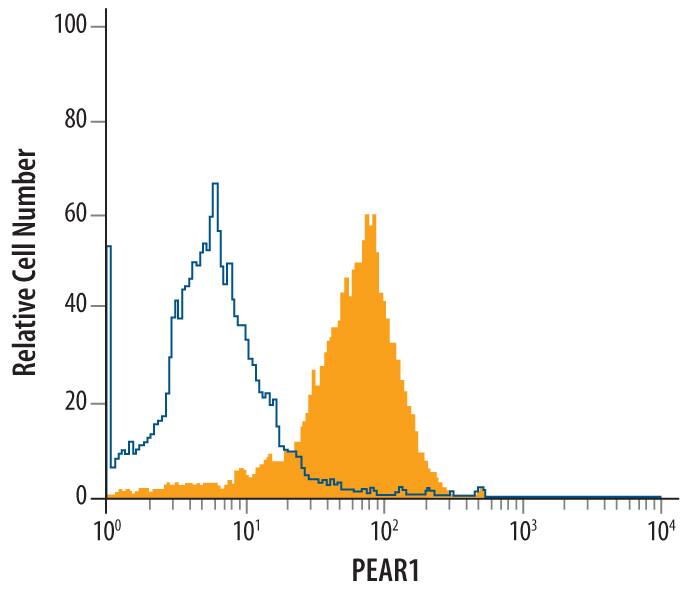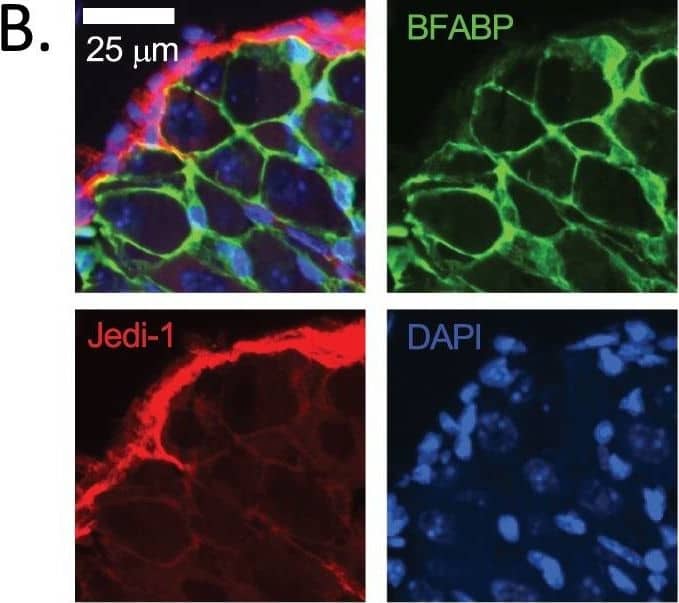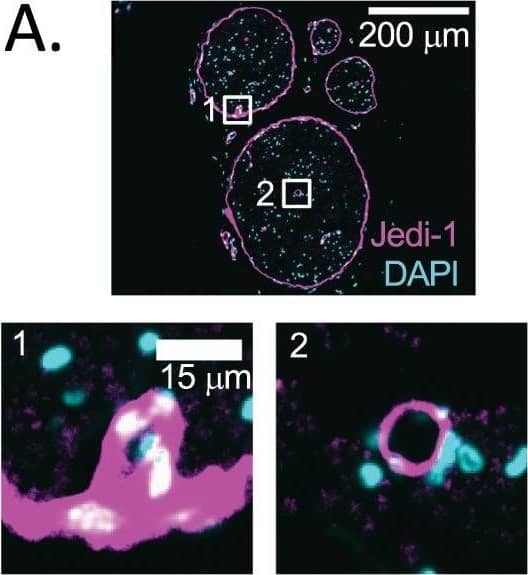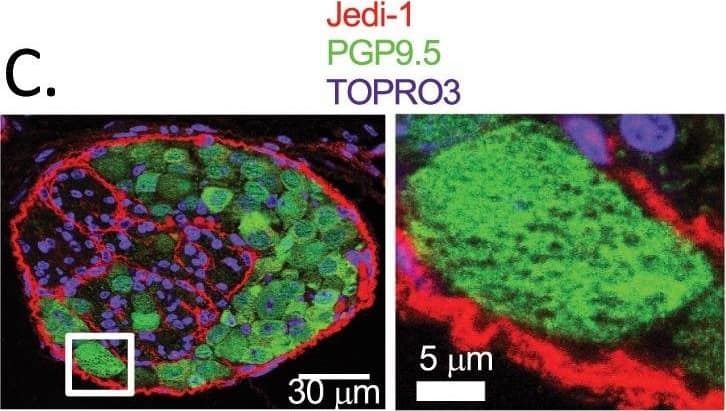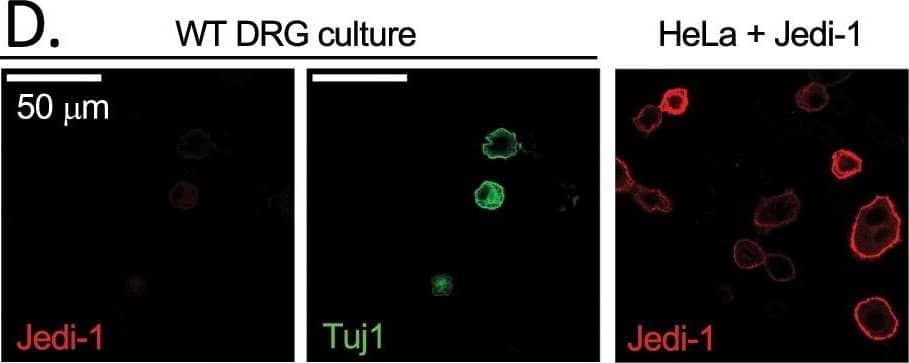Mouse PEAR1 Antibody
R&D Systems, part of Bio-Techne | Catalog # AF7607

Key Product Details
Species Reactivity
Validated:
Cited:
Applications
Validated:
Cited:
Label
Antibody Source
Product Specifications
Immunogen
Leu19-Leu754
Accession # Q8VIK5
Specificity
Clonality
Host
Isotype
Scientific Data Images for Mouse PEAR1 Antibody
Detection of Mouse PEAR1 by Western Blot.
Western blot shows lysates of mouse spleen tissue and mouse platelets. PVDF membrane was probed with 1 µg/mL of Sheep Anti-Mouse PEAR1 Antigen Affinity-purified Polyclonal Antibody (Catalog # AF7607) followed by HRP-conjugated Anti-Sheep IgG Secondary Antibody (Catalog # HAF016). A specific band was detected for PEAR1 at approximately 120-150 kDa (as indicated). This experiment was conducted under reducing conditions and using Immunoblot Buffer Group 1.Detection of PEAR1 in bEnd.3 Mouse Cell Line by Flow Cytometry.
bEnd.3 mouse endo-thelioma cell line was stained with Sheep Anti-Mouse PEAR1 Antigen Affinity-purified Polyclonal Antibody (Catalog # AF7607, filled histogram) or isotype control antibody (Catalog # 5-001-A, open histogram), followed by Phycoerythrin-conjugated Anti-Sheep IgG Secondary Antibody (Catalog # F0126).Detection of Mouse PEAR1 by Immunohistochemistry
Jedi is expressed in peripheral glia and endothelium. (A) Cross section of adult (8–12 weeks old) WT sciatic nerve stained for Jedi-1 (magenta) and DAPI (blue). Insets 1 and 2 show Jedi expression in blood vessels. See Supplementary Fig. S2 for validation of Jedi-1 expression in perineurial glial cells. (B) WT P0 DRG co-stained for Jedi-1 (red), satellite glial marker BFABP (green), and DAPI (blue). (C) WT DRG co-stained for Jedi-1 (red) and PGP9.5 (green) and TOPRO3 (blue). Right shows inset. (D) Right: Primary WT DRG cultures stained for neurons using Tuj1 (green) and Jedi-1 (red). Left: HeLa cells overexpressing mouse Jedi-1 were used as a positive control for Jedi-1 immunocytochemistry in vitro. All images were analyzed in ImageJ version 2.0.0-rc-69/1.52p. Image collected and cropped by CiteAb from the following publication (https://pubmed.ncbi.nlm.nih.gov/31992767), licensed under a CC-BY license. Not internally tested by R&D Systems.Applications for Mouse PEAR1 Antibody
CyTOF-ready
Flow Cytometry
Sample: bEnd.3 mouse endothelioma cell line
Western Blot
Sample: Mouse spleen tissue and mouse platelets
Formulation, Preparation, and Storage
Purification
Reconstitution
Formulation
Shipping
Stability & Storage
- 12 months from date of receipt, -20 to -70 °C as supplied.
- 1 month, 2 to 8 °C under sterile conditions after reconstitution.
- 6 months, -20 to -70 °C under sterile conditions after reconstitution.
Background: PEAR1
PEAR1 (Platelet Endothelial Aggregation Receptor 1; Also Jedi/Jagged and Delta protein and MEGF12) is a 140-160 kDa member of the MEGF/Multiple Epidermal Growth Factor domain family of molecules.It has restricted expression, being found on megakaryocytes/platelets, vascular endothelial cells, early hematopoietic stem cells and dorsal root ganglia satellite glial cells. PEAR1 has an extracellular domain (ECD) similar to Jagged1, and soluble PEAR1 is known to be an inhibitor of notch signaling. Thus, it likely participates in blood cell differentiation. It also is reported to bind to apoptotic neurons, facilitating clearance during development. Mature mouse PEAR1 is a 1016 amino acid (aa) type I transmembrane protein. It possesses a 736 aa ECD (aa 19-754) plus a 259 aa cytoplasmic region (aa 776-1034). The ECD contains one EMI (Emilin) domain (aa 25-137), followed by 9 EGF-like repeats (aa 181-691). There are at least three utilized phosphorylation sites in the cytoplasmic tail. Three isoform variants exist. One shows a deletion of aa 375-404, a second contains an 11 aa substitution for aa 737-747, and a third utilizes an alternative start site at Met137. Over aa 19-754, mouse PEAR1 shares 94% and 85% aa sequence identity with rat and human PEAR1, respectively.
Long Name
Alternate Names
Gene Symbol
UniProt
Additional PEAR1 Products
Product Documents for Mouse PEAR1 Antibody
Product Specific Notices for Mouse PEAR1 Antibody
For research use only
